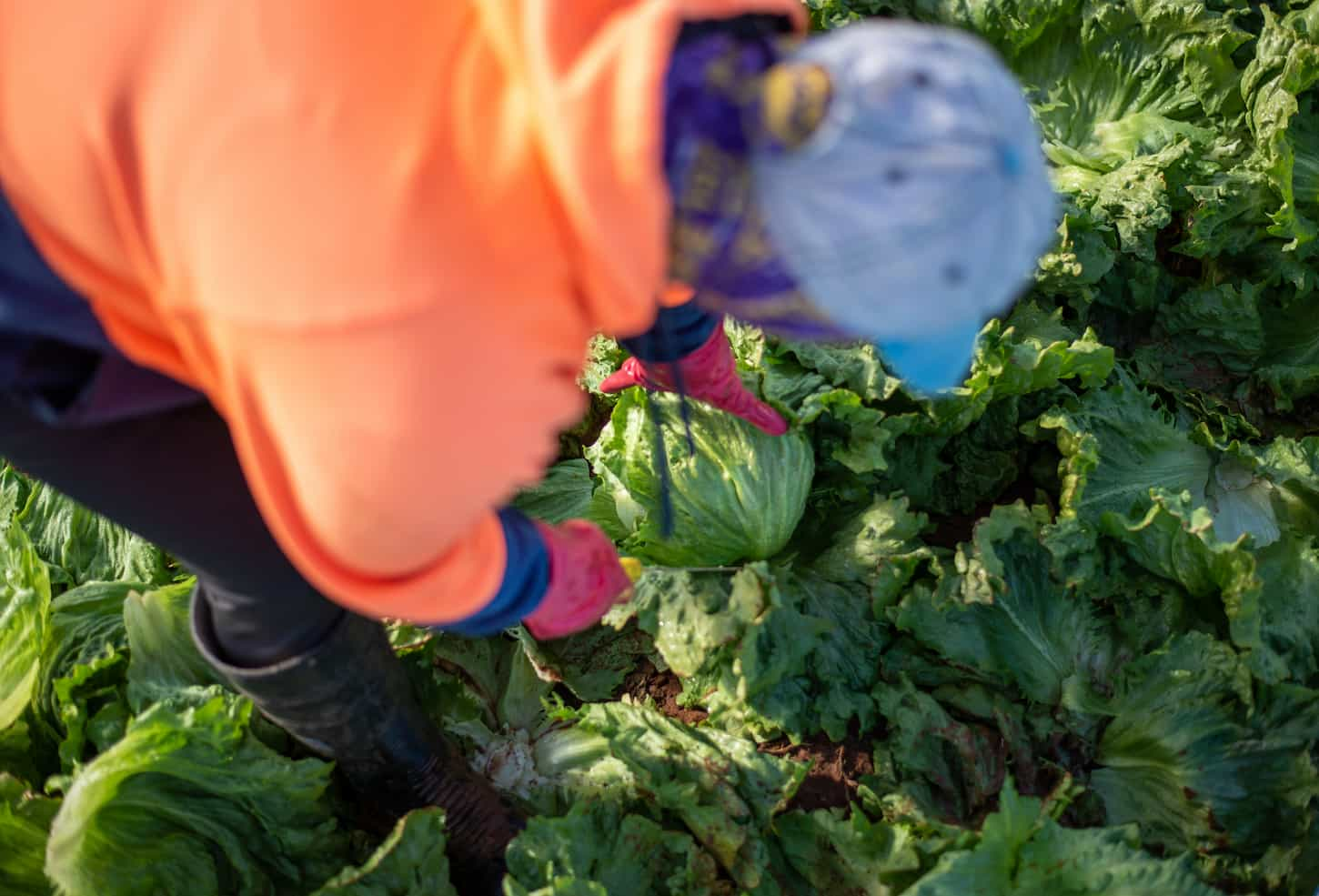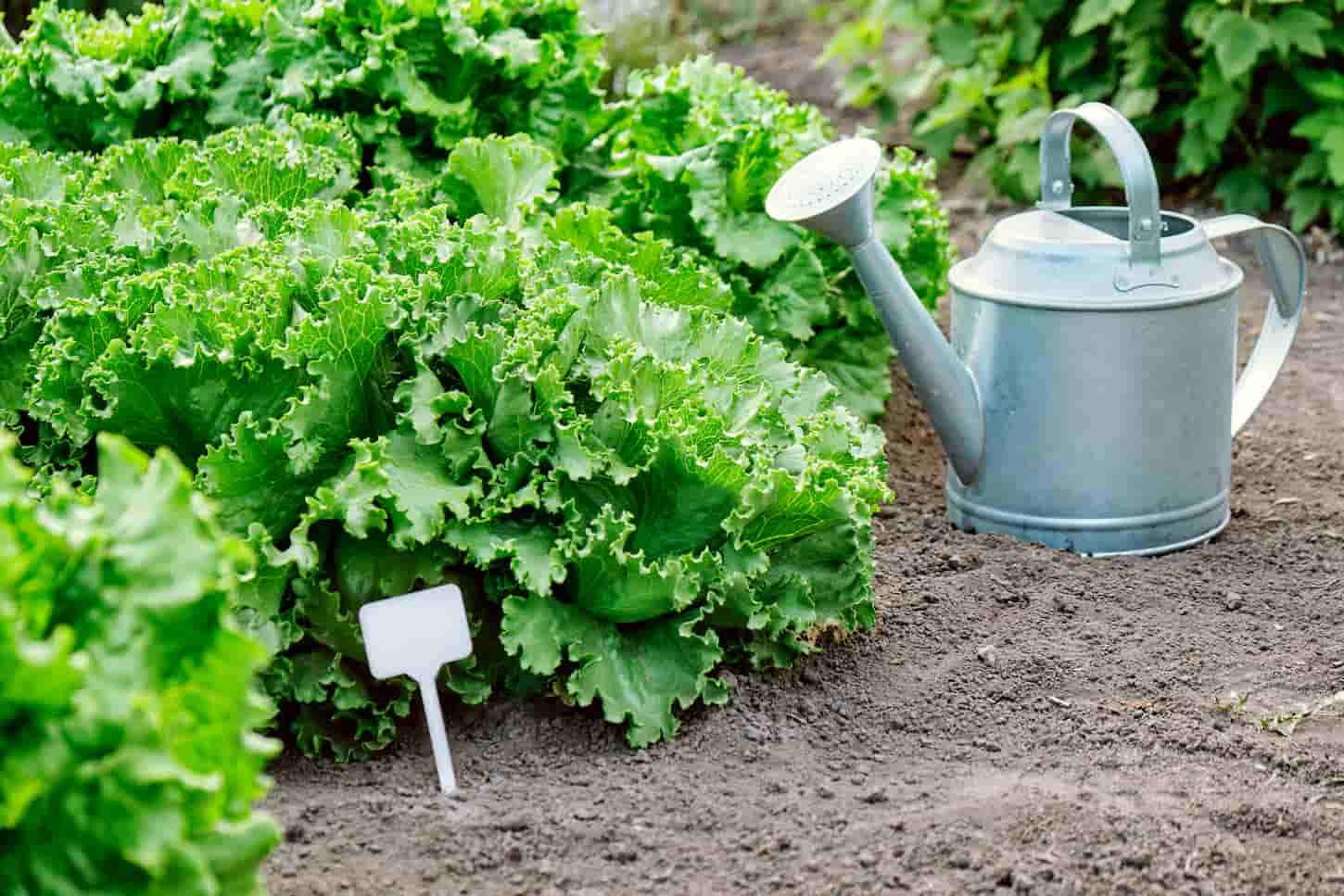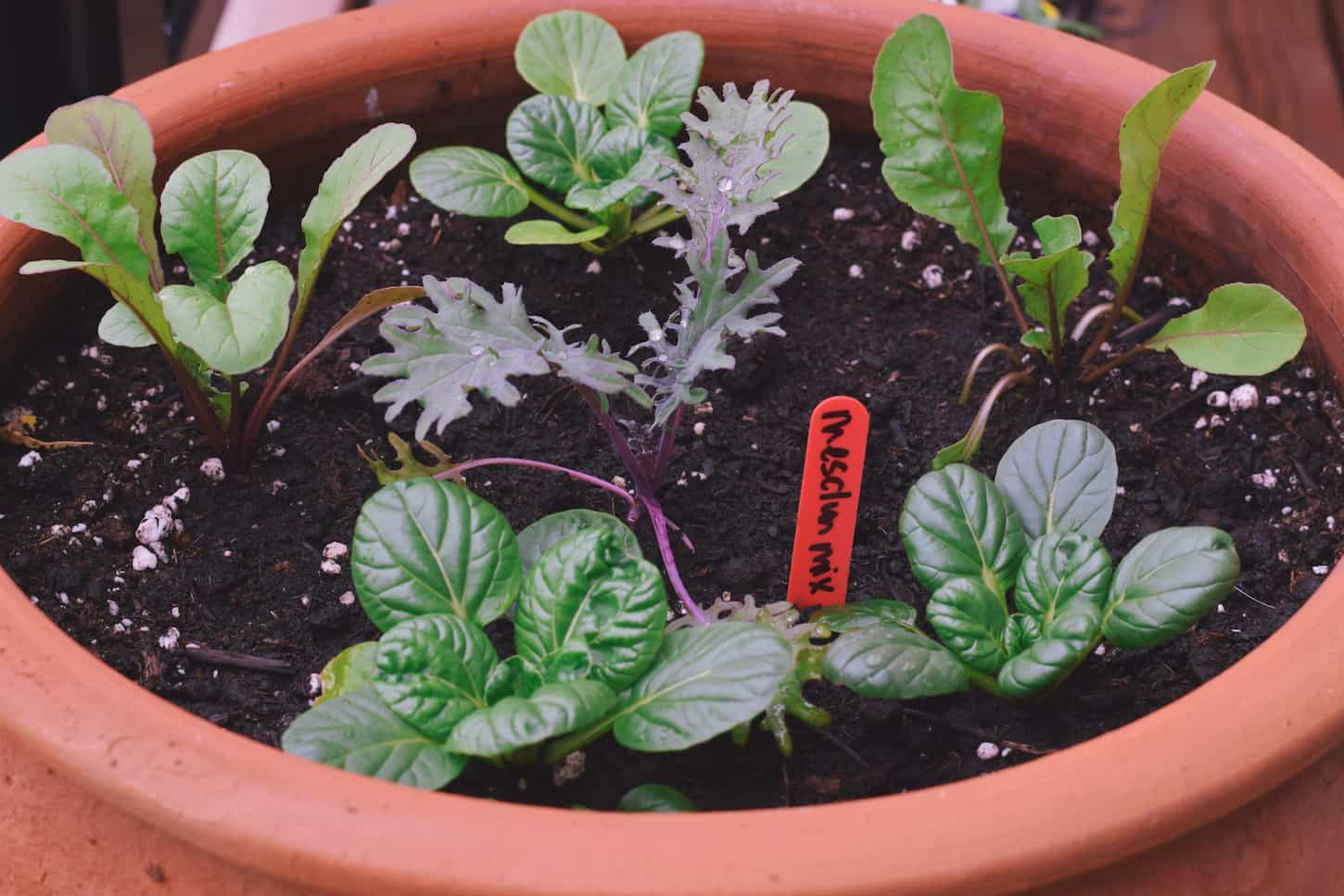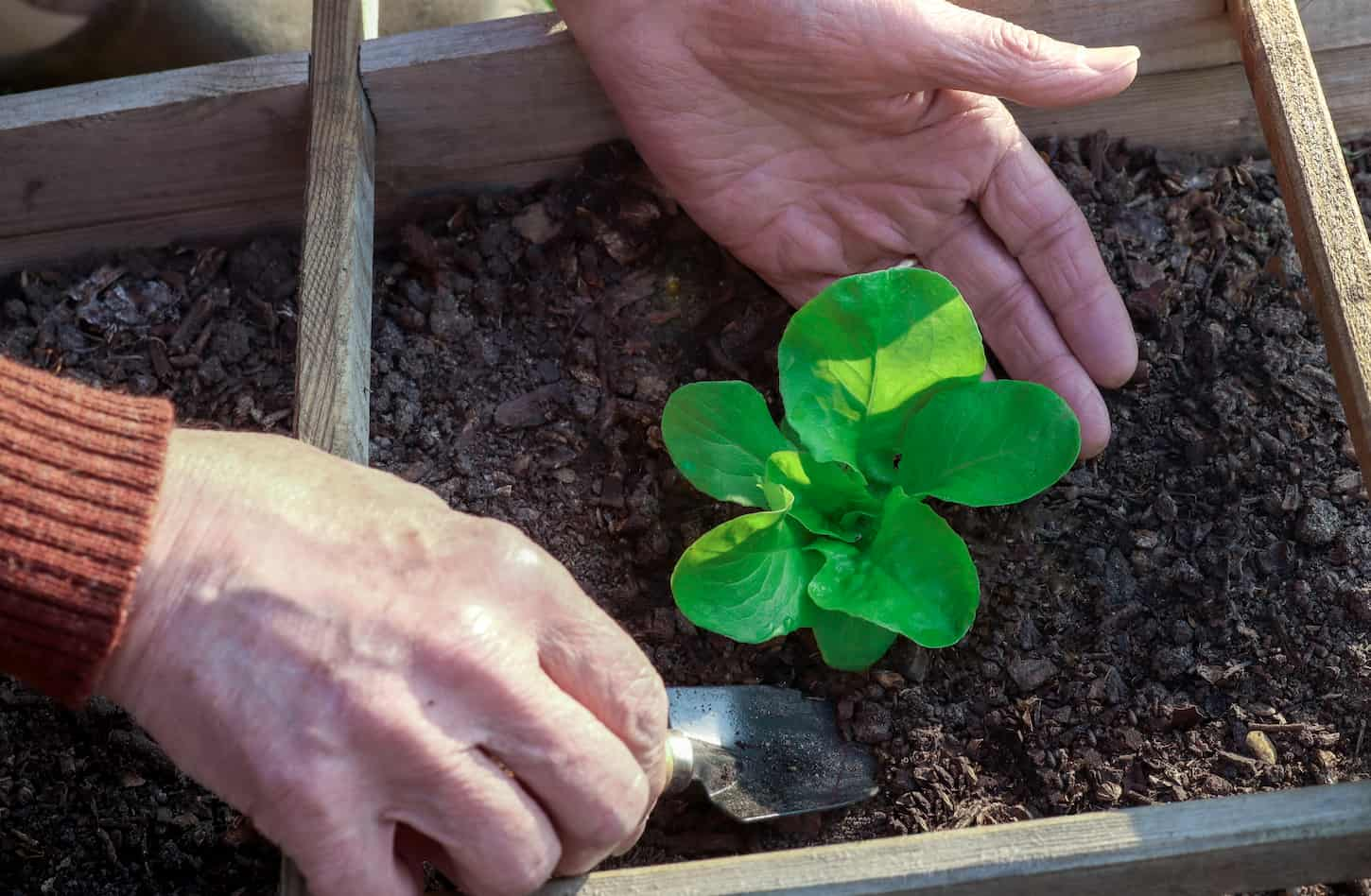Lettuce is the nation’s favorite leafy green, and it’s so satisfying to harvest a fresh, crisp head of lettuce from your garden. But did you know you don’t have to cut the whole plant all at once? If you harvest the leaves correctly, you can have a fresh supply of lettuce throughout the season. So how exactly do you remove lettuce leaves without fatally damaging the plant?
To harvest lettuce leaves without killing the plant, wait until the outer leaves are at least 4 inches long. Use gardening scissors to cut mature leaves at least an inch away from the crown. If you cut too close to the crown, you’ll kill the plant.
This method works best with loose-leaf lettuce, but you can also harvest head lettuce in a way they can grow back too. So, if you want to find out how to maximize and lengthen your lettuce harvest, we’ll take you through the complete process below.

Lettuce Facts
Lactuca sativa, also known as lettuce, is a leafy, annual plant that goes to seed each year. It’s from the Aster family of plants, which also includes dandelions and artichokes. Lettuce is quick growing, doesn’t depend on pollination, and comes in many different shapes and colors.
Lettuce likes a cool environment, so it’s better to grow it in the spring and fall. They’re moisture-loving plants, so they need lots of water in warm weather. The great thing about lettuce is that you can grow it anywhere, including in raised beds, pots, and containers. And you can even grow it indoors if you don’t have a garden.
Not only is lettuce tasty, fresh and delicious, but it’s super healthy too. It contains only a trace of fat, very few calories, and lots of vitamins and minerals. These include vitamin K, potassium, phosphorus, and folates, which are great for your blood, muscles, and bones. Lettuce also contains vitamin A which is good for your eyes.
Botanically speaking, there are four types of lettuce. These are head, loose-leaf, romaine, and celtuce.
- Head Lettuce is named after its large, round shape. Types of head lettuce include iceberg and butterhead.
- Loose Leaf Lettuce isn’t as compact as head lettuce. Their leaves separate and splay out from the crown. Black Seeded Simpson and Austrian Green are examples of loose-leaf lettuces.
- Romaine Lettuce is distinctive due to its tall, narrow head and crisp leaves. Cos lettuce is a type of romaine.
- Celtuce Lettuce is a type of stem lettuce. It has a thick stem and long, tall leaves, and it’s not very common here in the USA.
Will Lettuce Grow Back After Cutting?
If you harvest it the right way, without severely damaging the plant, both loose leaf and head lettuce will grow back after cutting. Head lettuce will regrow from the stem, while loose leaves will reproduce new leaves from the crown.
It’s hard to harvest individual leaves from head plants because they’re so compact. But, if you leave enough of the stem in the ground when you cut down a whole head, another lettuce will usually regrow in its place. However, the second lettuce to come through will be looser than the first.
It’s much easier to harvest individual leaves from loose-leaf lettuce because you have better access to the stems. As long as you don’t damage the crown of loose-leaf lettuce, the leaves will grow back. The crown of the lettuce is the central part where the leaves grow from.
But bear in mind, that your lettuce will stop regrowing after a certain point. Lettuce is an annual plant, and it will die off at the end of a growing season.

How To Harvest Lettuce so It Keeps Growing
If you want to harvest loose leaf lettuce so it keeps growing, you must remove the leaves without damaging the crown. For head lettuce, you must leave at least 1 inch of its stem above the earth so that it can regrow.
To get a clear idea about this, below, we’ll tell you exactly how to harvest head and loose-leaf lettuce so they keep growing.
Head Lettuce
Head lettuce such as butterhead and iceberg will usually be ready between 50 and 70 days after sowing. You’ll know they’re ready when the heads are well-formed and compact.
To harvest head lettuce without killing the plant, use a sterilized gardening knife or shears. Cut the plant at the base of its stem, and make sure you cut the leaf a minimum of one inch above the soil, without damaging the roots. Keep watering the stem, and in another 50-60 days, you should have another lettuce.
You can also use this process for romaine lettuce. All head types will regrow if you cut them properly, and potentially, you can get another 2-3 harvests from them. You can also harvest individual leaves from head lettuce. To do this, use the harvesting technique for loose-leaf lettuce, which we’ll explore below.
Loose Leaf Lettuce
You can harvest the baby leaves from loose-leaf lettuce around 30 days after planting when the leaves are a minimum of 4 inches long. Use sterilized gardening scissors to remove the outer, mature leaves, and let the inner ones grow.
When you cut the leaves away from the plant, make sure that you leave at least 1 inch of the leaf remaining. The extra vegetation will protect the crown and help the leaves regrow. If you cut into the crown or too close to it, you’ll kill your lettuce.
This type of harvesting is known as the cut-and-come-again method. And you should harvest the leaves just before they’re fully mature for the best texture and taste.
How Do You Pick Lettuce Off the Plant?
The best way to remove lettuce from your plant is with sterilized gardening scissors or pruning shears. These provide a clean, accurate cut. You can also use your fingers to remove leaves, but this is more damaging to the plant.
When you remove leaves with your fingers, you risk damaging your lettuce. If you pull the leaves off, you can easily take too much of the leaf by mistake, causing damage to the crown. As well as this, if the leaf isn’t clean-cut, it may take longer to grow back.
For the best results, use pruning shears or scissors to harvest leaves. These provide a clean, healthy cut. Rub your scissors with alcohol between prunings to reduce the chance of contamination.
Harvest your lettuce in the morning for maximum crispiness and freshness. And make sure you keep giving your plants plenty of water to help them regrow and recover from the stress of harvest.
How Many Times Can You Harvest Lettuce from One Plant?
Under the right conditions, one head lettuce plant can produce up to 5 more heads after the first harvest. And you can harvest the leaves of loose-leaf lettuce over and over, so long as they keep growing.
It takes head lettuce around eight weeks to produce a new head after harvest. The leaves of loose-leaf lettuce will be ready to harvest again in around fourteen days. So long as you do it correctly, pruning lettuce leaves is good for the plant. It will encourage it to grow and will ultimately prolong its life.
Extend your lettuce season by planting different varieties and sowing them at intervals of a week or two apart. Alternatively, sow a load of seeds all at once and “thin them out” as they grow. You can harvest the small plants for your kitchen while making room for the other ones to mature, and this is a good method for no-till gardening.
Towards the end of the lettuce’s life cycle, it will bolt. And once your plant has done this, the leaves will become bitter and inedible.

What is Bolting?
Bolting is when your lettuce starts to flower and produce seeds. Bolting happens at the end of the growing season or if the lettuce is subject to a lot of stress. Most lettuce will bolt as summer temperatures increase.
Lettuce prefers cool climates of around 60 – 66 Fahrenheit. So before the temperature gets too hot, between 70 and 80 Fahrenheit, they turn their energy into producing seeds. Once this happens, the leaves will taste bitter and have a tough texture.
When lettuce is bolting, it will produce an elongated flower stalk from its center. You can cut this stalk down to delay the flowering process.
You can also delay bolting by reducing the amount of sunlight your lettuce receives. The best way to do this is with a garden net. The net will also reduce the temperature of your lettuce.
The stress of dehydration may also cause your lettuce to bolt, so make sure you keep your lettuce well-watered, especially in hot weather.
Bolting isn’t all bad, and it’s a good idea to let some of your plants develop flowers and seeds. You can plant the seeds from your lettuce the following year. Once your lettuce is past its best, you can feed it to your chickens if you have any or add it to your compost.
What’s the Best Way to Store Lettuce?
Once harvested, lettuce needs cool temperatures to stay crisp and fresh. The best way to store it is in Tupperware, or a Ziploc bag in the salad compartment of your refrigerator.
Before you store lettuce, cut off the core of the head of the lettuce, and rinse away any dirt. Next, wrap the head or leaves in some paper towels to absorb the moisture, but don’t compress them. Then, put the lettuce in a Tupperware container or Ziploc bag but always leave the corner open because the lettuce needs some air.
Lettuce can last for up to 10 days in the salad compartment of your refrigerator. And if your lettuce wilts, put the leaves in a bowl of cold water along with some ice cubes. After 15 minutes, it should be fresh and crisp again.
Lettuce Grow Tips
Lettuce grows best in well-draining, fertile soil between pH 6-7, and they are leafy plants, which means they need lots of nitrogen. Treat the earth with compost a week before planting. Then feed them with nitrogen-rich fertilizer or organic matter three weeks after they go into the ground.
Lettuce seeds are tiny and won’t do well on stony earth or with competition from weeds. Give your lettuce plants a layer of mulch to suppress weeds and keep fall crops warm. Mulch will also act as a slow-release fertilizer and help your plants retain moisture.
You can sow lettuce directly in the ground after the last frosts in the spring. Or, start them off indoors for an early crop. Head lettuce needs more space than loose-leaf types, so account for this when you plant them.
Lettuce needs lots of shade and doesn’t like full sunlight. They should get most of their sun when it’s weaker in the morning. Cover your lettuce in a sun net if you live in a sunny climate or your garden gets lots of suns.
You can plant lettuce among other leafy greens such as spinach and chard, and they thrive when you plant them with insect repellent plants such as chives, and garlic. Or, for extra shade, grow lettuce between taller plants.
And finally, lettuce is dramatic and will wilt on a hot day as soon as it’s thirsty. If your lettuce plants wilt, give them a drink to revive them, no matter what time of the day.
Best Lettuce Products
Want to skip some of the learning curves and get the best products that make growing and harvesting lettuce easier? We’ve got you covered.
Try one of these options if you need something to cut and harvest your lettuce.
- Try a Hori-Hori knife (like this one on Amazon) that works for both weedings, digging, and cutting in the garden.
- If you’d prefer to stick to a straight-style pruning shear, these 6 1/2-inch pruners (on Amazon) are a great option. I love the color choice, too. Not because I like oranges, but because I can actually find them in the garden.
- While I don’t have this set of professional Bonsai scissors from Amazon, I hear great things about them from neighbors and friends.
Need to fertilize your lettuce? Here are some options.
- Your best bet is honestly to go shopping for vegetable and tomato fertilizers at your local nursery. Odds are, they’ll have the best price.
- If the nursery is out of stock or the price is unreasonable, shop for plant fertilizers on Amazon. Or just use this link to price compare while you’re at the nursery.
The last product I’m going to recommend to you could help shade the lettuce, but mostly it’s so you don’t get sunburned while gardening.
- Get a garden sunshade (like this one on Amazon) and put it up in your garden. You can angle it to help provide some afternoon shade so your lettuce (or other plants) don’t get sun-scorched.
However, even if you do put up a sunshade, think about wearing sunblock if you’re going to be outside for a long time in the summer sun. Being sunburned isn’t fun for anyone!

Next Steps
As you can see, it’s easy to harvest lettuce without killing the plant. Just make sure that you cut the leaves of loose-leaf lettuce at least an inch away from the crown. If you want to harvest a whole lettuce plant, leave at least an inch of the stalk in the earth when you remove the head. Continue with regular watering to encourage the lettuce to grow back again. When you harvest lettuce in this way, you can enjoy a very fruitful and prolonged lettuce season.
Now that you know more about harvesting lettuce, make sure that you never deal with dirty-tasting lettuce again: Why Does My Lettuce Taste like Dirt? (4 Possible Reasons). Go give that a read next, and you’ll never have to choke down earthy-tasting lettuce again.
Resources
It’s important to learn from your own experience, but it’s also smart to learn from others. These are the sources used in this article and in our personal research to be more informed as homesteaders.
- Dufault, Robert J., et al. “Dynamic Relationships between Field Temperatures and Romaine Lettuce Yield and Head Quality.” Scientia Horticulturae, vol. 120, no. 4, 2009, pp. 452–59. Crossref, doi:10.1016/j.scienta.2009.01.002.
- Hao, Jing-Hong, et al. “Quantitative Proteomics Analysis of Lettuce (Lactuca Sativa L.) Reveals Molecular Basis-Associated Auxin and Photosynthesis with Bolting Induced by High Temperature.” International Journal of Molecular Sciences, vol. 19, no. 10, 2018, p. 2967. Crossref, doi:10.3390/ijms19102967.
- “Lettuce.” Almanac.com, www.almanac.com/plant/lettuce.
- “Lettuce | Description, Varieties, and Facts.” Encyclopedia Britannica, www.britannica.com/plant/lettuce. Accessed 21 Dec. 2021.
- University of California, Division of Agriculture and Natural Resources. “Growing Lettuce Year Round.” © 2021 Regents of the University of California, 2015, mgsantaclara.ucanr.edu/garden-help/vegetables/lettuce/growing-lettuce-year-round.
